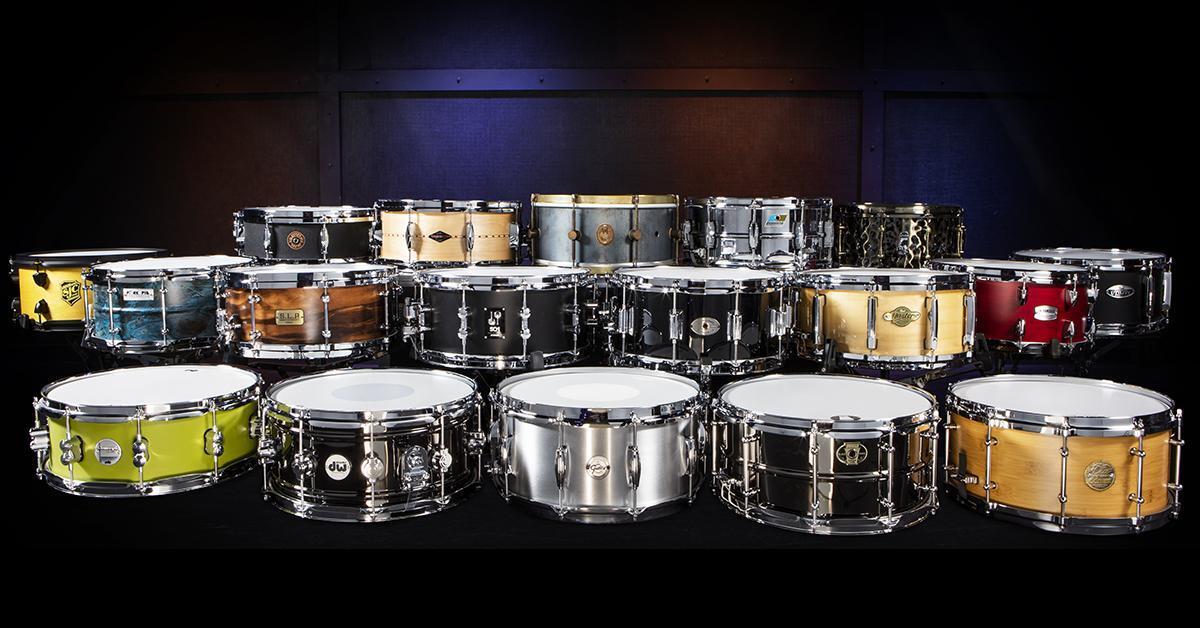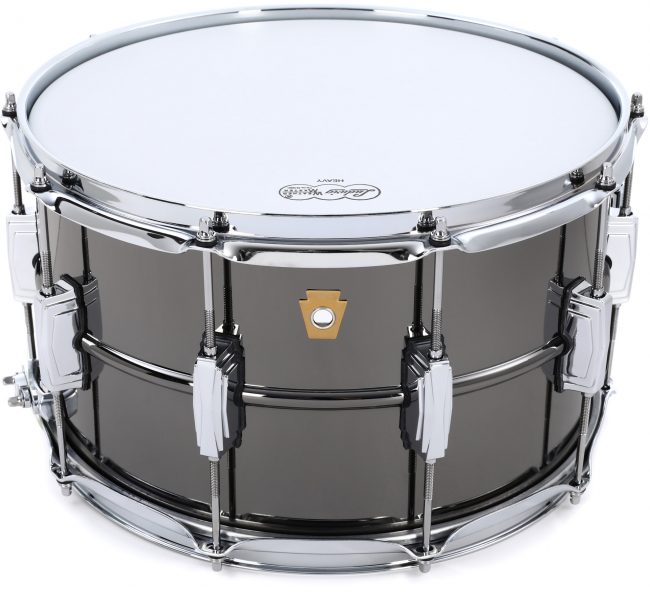2025 Snare Drum Buying Guide
The snare drum is arguably the most important sound behind the kit. It’s certainly the most recognizable. Catch five seconds of “Hurts So Good,” “St. Anger,” or “Blank Space” over a lobby speaker, and you instantly have an idea of what decade and genre of music you’re listening to. This underscores the points that, when it comes to snare drums, you can’t overspend on quality, and variety is key to getting the right sound for a record.
Drumfluence is reader-supported. When you make a purchase through links on our site, we may earn an affiliate commission at no extra cost to you. Learn more.

Whether you’re a drummer who’s chasing a sound you can’t get with your current snare or a recording engineer who’s looking to load up your studio for all manner of musical stylings, we recommend Sweetwater’s Snare Drum Buying Guide to help you navigate the sometimes-murky waters of snare drum options — shells, hoops, hardware, and beyond. Check out the guide below:
Shell Material
The key to building a broad collection of snare sounds
If you’ve ever wondered what accounts for the breadth of snare options at Sweetwater, it’s the variety of shell materials we carry. That’s because shell construction plays a critical role in the sound, output, and response of every snare drum we stock. From the dry, smoky pop of an oak snare to the zing and sensitivity of a brass snare, shell type can play a huge part in how the instrument speaks and responds in the player’s hands. Here are the major shell options today; note that this is not an exhaustive list.
Wood

- Maple — When it comes to wood snares, North American maple (a.k.a. hard maple or rock maple) accounts for the lion’s share of options on the market. Why?
- It’s extremely balanced across the entire audible spectrum.
- It’s durable enough to survive the occasional drop, kick, and tumble across a stage.
- As a tonewood, it can be manipulated to create a massive range of sounds. Beyond rock maple, European and Asian maple are two other common options you’ll find used in snare shells. European maple shares many tonal properties with North American maple. Asian maple is a softer wood that tends to deliver a fatter, fuzzier tone.
- Mahogany — Fifty years ago, mahogany was the de-facto material for snare shells. Today, it’s still a solid contender for players who want a darker, warmer sound and heftier midrange punch from their snare drum.
- Birch — Compared to maple, birch is typified by a brighter tone and a more focused attack. Its crisp, dry “pop” excels in the studio setting.
- Poplar — Soft, affordable poplar wood has really made a comeback in snare shells over the last 10 years. This is due in part to its chewy, broadband response and exciting striated wood grain when used as a finish ply.
- Walnut — Walnut is a dense tonewood that boasts a powerful bottom end, an articulate snare sensitivity, and a leveling rimshot that can really clear a room.
- Cherry — According to snare whisperer John Good of DW Drums (check out our interview with John about tonewoods), cherry exhibits a darker, gutsier sound than maple and a richer bottom end. Cherry is also said to have an extremely high dynamic range; whereas other shells may “bottom out” when hit too hard, cherry tends to be able to return more energy in the fff playing zone.
Metal

- Brass — When it comes to metal snare drums, few alloys are more prized than brass. It’s warm when feathered, bright and aggressive when pummeled, and extremely articulate when fed ghost notes.
- Steel — What brass has on sensitivity, steel snares have on attitude. A good steel snare is able to deliver the raucous bite and howling note length that wood snares often cannot.
- Aluminum — This alloy is a sleeper favorite among snare players. It’s sensitive and earthy when played soft and opens up to a polite bark with a fat bottom end as you play out.
- Copper — Famous for its use in kettledrums to patio furniture, copper is a relative newcomer to the world of snare drums. It’s marked by raw, dark overtones and a throaty articulation as you move from the edge to the center of its playing surface.
- Bronze — Some of the finest Turkish cymbals and orchestral gongs in existence have been crafted from B20 bronze (a.k.a. bell bronze). As a snare metal, bronze is expressive and dynamic, with enough range and versatility to take you wherever you want to go in your music.
Other

- Acrylic — We have the Ludwig family to thank for paving the way for acrylic drum shells, beginning in the 1970s. As a snare material, acrylic is dry, throaty, and full, with a backbeat that goes off like a bomb blast. As an added visual treat, acrylic snares can be made to look windowpane clear, see-through tinted, or totally opaque.
What snares should I get if I’m just starting?
If you’re a drummer or recording engineer who’s just starting to build your snare drum collection, a maple snare, a steel snare, and an acrylic snare make for a versatile tonal trio. These snares will give you the tools you need to suit most musical styles.
Shell Diameter
Determines tuning range
A snare drum’s diameter — how large its playing surface is — accounts for the range of tones it’s able to produce. All things equal, a smaller snare drum diameter (10- to 13-inch) will exhibit a brighter, higher-pitched sound. A larger snare drum diameter (14- to 16-inch) will yield a deeper, darker sound.
Note that these differences pertain to shells of the same construction, thickness, tuning, etc. A low-tuned 13-inch copper snare could produce a deeper fundamental than a cranked 15-inch maple snare. But as a general rule of thumb: larger means deeper, smaller means higher.
Shell Depth
Responsible for speed and fullness
A snare’s depth, on the other hand, is most responsible for its body, bloom, and resonance. A snare such as the A&F Pancake Snare (1.5-inch deep by 14-inch diameter) may be able to produce the same range of fundamentals as the Ludwig Black Beauty (8-inch deep by 14-inch diameter). But where you’ll often notice the differences will be in each snare’s response speed and fullness of sound. A deeper shell is often characterized by a fatter, slower attack. A thinner shell tends to be drier (less resonant), crisper, and quicker to speak.
Shell Thickness
Plays a factor in pitch, output, and resonance
Another consideration is the thickness of the snare shell. You’ll often see this measured in number of plies (“6-ply,” “20-ply,” etc.) in wood snares or millimeters (“1.2mm,” “5.0mm,” etc.) in metal and acrylic snares. Thickness often contributes both to pitch (greater thickness = greater mass = a higher tone) and projection (higher density = a louder output). Thinner snares and snares made with fewer plies, such as vintage options, are often associated with a darker, more resonant tone. Note that this is a generality. Some snares, such as the space-age Dunnett Classic MonoPly, are crafted from a single plank of steam-bent maple to eliminate the imprecision of traditional plywood shell making.
Hoops
Augments the sound of your shell
Counterhoops (or simply hoops) also play a big part in a snare’s overall sound and response. These wood and metal rings act as tensioners between the drumhead and the shell’s bearing edge. And, as resonating bodies themselves, hoops can be used to enhance and rarify the harmonic content of your snare. Here’s an overview of the main hoop types you’ll find on snares at Sweetwater, from most common to least.
- Triple-flanged hoops — These thrice-bent counterhoops are far and away the most common hoops used in modern snare drums, and for good reason. Durably built and inexpensive to make, milled triple-flanged hoops mark a major shift in the counterhoop technology of the mid-20th century. Modern triple-flanged hoops are available today in 1.6mm, 2.3mm, and 3.0mm thicknesses. Thinner 1.6mm hoops are thought to allow heads to “breathe” more, which is why they’re associated with vintage drums. Thicknesses of 2.3mm and 3.0mm are more durable and rigid, which tend to reveal a drier, more focused sound.
- Die-cast hoops — Whereas triple-flanged hoops are shaped and welded from flat-stock metal and are thus prone to bending, warping, and occasionally cracking, die-cast hoops are created from liquid metal poured into a molded cavity and left to harden. This produces a hoop that is not only impervious to bending and breaking, but also one that can enhance the definition, focus, purity, and power of a shell. Read our feature on die-cast hoops for more information.
- S-Hoops — Think of these specialty steel hoops from Safehoop as a hybrid between traditional flanged and cast hoops. They supply a dryness and power similar to cast hoops but with a chunkier attack and without the “dinner bell” harmonic ring of flanged hoops.
- Double-flanged hoops — These less-common “stick choppers” played a key role in the classic Gretsch snare sound. They lack the top flange of modern triple-flanged designs. You’ll still find them today on Gretsch snares and throwback styles.
- Single-flanged hoops — Less common still are the field-drum-style single-flanged hoops used on vintage-looking drums, such as those employed by A&F today.
- Wood hoops — Multi-ply wood hoops are occasionally found on snare drums at Sweetwater. These hoops apply the unique visual and tonal characteristics of their particular tonewood (maple, mahogany, etc.) to a snare drum.
Now while it’s true that hoops, as with heads and snare wires, can be replaced down the line, these parts can be expensive to source. You’re better off getting the right hoops for the sound you’re after at the time of purchase.

Snare Wires
Unsung heroes of a great snare sound
The snare wires themselves may be a factor to consider for your next snare drum purchase. Snare wires are easy to replace on your snare down the road, but you get the most value by sticking with a sound you trust. Want to hear them in action? Check out our article “Do Snare Wires Really Change Your Sound? – with Sound Samples” snare wire shootout.
Throw Offs and Butt Plates
Your connection to the sound of your snare
The mechanisms that hold snare wires against a snare drum’s bottom head are the throw off and butt plate. While any modern snare system will do a serviceable job of simply engaging and tensioning snare wires, several factory snares today come loaded with upgraded hardware built with the discerning drummer in mind. Take the Trick 007 multi-step throw off and DW 3P butt plate, for example. These options give you three distinct snare tensions beyond their normal on/off functions. This makes it quick and easy to adjust note length and tightness in the middle of a song — something to keep in mind if you’re particular about snare performance!

Sweetwater: The Drummer’s Source for Snares!
Whether you’re looking to grow your snare family by a single drum or by an entire fleet, Sweetwater is the drummer’s source for snare drums. Give your Sweetwater Sales Engineer a call at (800) 222-4700 and ask them about the Drumfluence Special Deal if you’re looking to round out your snare collection.
Join Our Beyond the Beat Newsletter
All the latest drums news, interviews, lessons, reviews, deals and more, direct to your inbox!




